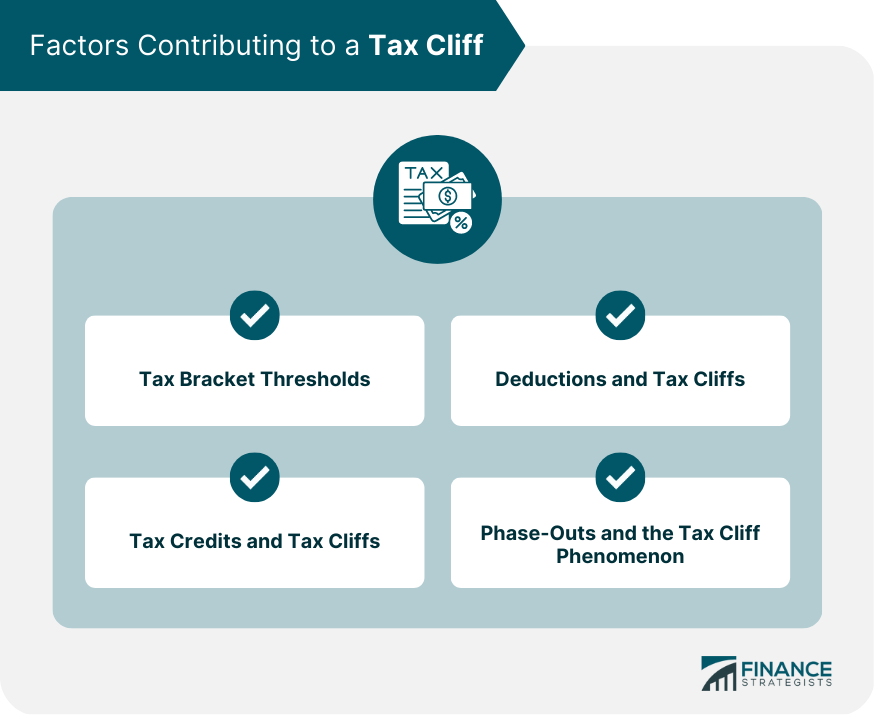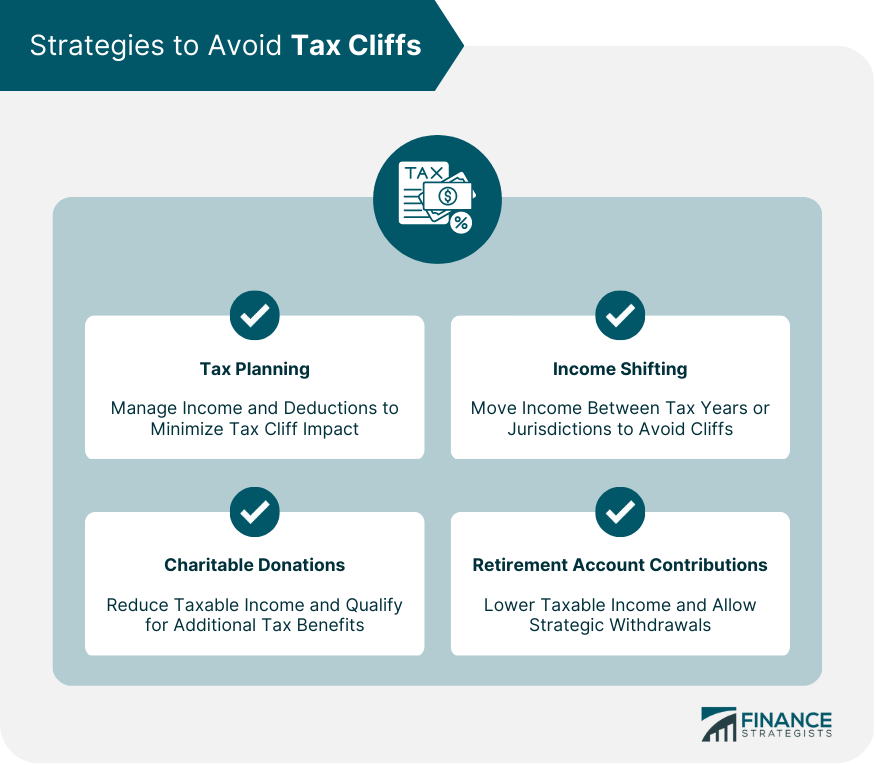A tax cliff is a situation where a slight increase in income pushes a taxpayer into a higher tax bracket or reduces their eligibility for deductions or credits, resulting in a significant increase in tax liability. This can create a seemingly disproportionate tax burden compared to the actual increase in income. Understanding the tax cliff is crucial for both individuals and businesses, as it can have a significant impact on financial planning, decision-making, and overall tax strategy. Being aware of potential tax cliffs can help taxpayers make informed choices to minimize their tax liabilities and ensure they are not caught off guard by unexpected tax bills. The tax cliff can result in several potential consequences, such as reduced disposable income, financial stress, and distorted decision-making in areas like investing, business operations, and retirement planning. Tax brackets are income ranges with corresponding tax rates. Crossing a tax bracket threshold can lead to a tax cliff, as the higher tax rate applies to income above that threshold. Deductions, which reduce taxable income, can also contribute to tax cliffs. Certain deductions phase out or become unavailable as income rises, leading to higher tax liabilities. Tax credits, which reduce tax liability directly, can also create tax cliffs when they phase out or are eliminated at specific income levels. Many tax benefits, including deductions and credits, are subject to phase-outs at specific income levels. Phase-outs can create tax cliffs, as taxpayers lose these benefits and face increased tax liabilities. A tax cliff can occur when retirees withdraw funds from tax-deferred retirement accounts, pushing their income into a higher tax bracket or causing Social Security benefits to become taxable. Some Social Security benefits are tax-free, but as income rises, a larger portion becomes taxable. This can create a tax cliff for retirees with income from other sources. When investors sell assets, capital gains taxes may apply. Depending on income and the nature of the asset, crossing a threshold can lead to a tax cliff by pushing the taxpayer into a higher capital gains tax rate. Married couples filing jointly may face a tax cliff due to the marriage penalty, which occurs when the couple's combined income pushes them into a higher tax bracket than they would have been in as single filers. Tax planning, including income smoothing and deferring income or deductions, can help taxpayers avoid or minimize the impact of tax cliffs. Income shifting, such as moving income between tax years or shifting income from high-tax to low-tax jurisdictions, can help taxpayers avoid tax cliffs. Charitable donations can help taxpayers avoid tax cliffs by reducing taxable income and potentially qualifying for additional tax benefits. Contributing to tax-deferred retirement accounts can help taxpayers avoid tax cliffs by lowering taxable income and allowing for strategic withdrawals in retirement. Tax cliffs can distort economic behavior by incentivizing taxpayers to defer income, adjust investments, or make other decisions based on tax implications rather than financial merit. Tax cliffs can raise concerns about tax fairness, as taxpayers with similar incomes may face significantly different tax liabilities due to the structure of tax brackets, deductions, and credits. Policy proposals to address tax cliffs include adjusting tax brackets, reducing the number of phase-outs, or implementing gradual tax increases to minimize the impact of tax cliffs on taxpayers. Different countries have different tax systems, and the prevalence and severity of tax cliffs can vary. Comparing international tax systems can provide insights into potential tax cliff reforms and best practices for minimizing tax cliff consequences. Tax cliffs play a significant role in personal finance and tax planning. Understanding the factors contributing to tax cliffs, such as tax bracket thresholds, deductions, credits, and phase-outs, is crucial for making informed financial decisions. By being aware of potential tax cliffs and implementing strategies like income shifting, charitable donations, and retirement account contributions, taxpayers can minimize their tax liabilities and optimize their financial situations. Tax cliffs can have profound policy implications, affecting economic behavior and raising concerns about tax fairness. Comparing international tax systems and considering reform proposals can help create a more equitable tax landscape. Utilizing various resources, including government publications, tax software, calculators, and educational materials, can further enhance one's understanding of tax cliffs. As the complexity of tax laws and regulations increases, seeking professional tax advice becomes even more important. Tax professionals can provide personalized guidance on managing tax cliffs and ensuring long-term financial success.Definition of Tax Cliff
Importance of Understanding Tax Cliff
Potential Consequences of Tax Cliff
Factors Contributing to a Tax Cliff

Tax Bracket Thresholds
Deductions and Tax Cliffs
Tax Credits and Tax Cliffs
Phase-Outs and the Tax Cliff Phenomenon
Tax Cliff Examples
Tax Cliff in Retirement Planning
Social Security Benefits and Tax Cliff
Capital Gains Tax Cliff
Marriage Penalty and Tax Cliff
Strategies to Avoid Tax Cliffs

Tax Planning and Managing Tax Cliffs
Income Shifting to Prevent Tax Cliffs
Charitable Donations and Tax Cliffs
Retirement Account Contributions and Tax Cliff Avoidance
Tax Cliff Policy Implications
Tax Cliff’s Impact on Economic Behavior
Tax Cliff
Proposals for Tax Cliff Reform
International Comparisons of Tax Cliff Situations
Conclusion
Tax Cliff FAQs
A tax cliff is a situation where a slight increase in income pushes a taxpayer into a higher tax bracket or reduces their eligibility for deductions or credits, resulting in a significant increase in tax liability. Tax cliffs can lead to reduced disposable income, financial stress, and distorted decision-making in areas like investing and retirement planning.
To identify potential tax cliffs, consider factors such as tax bracket thresholds, deductions, credits, and phase-outs. Review your income sources and consult government publications, tax software, or calculators to estimate your tax liabilities and identify potential tax cliffs.
Strategies to avoid or minimize tax cliffs include tax planning, income shifting, charitable donations, and contributing to tax-deferred retirement accounts. These approaches can help lower taxable income, reduce tax liability, and allow for strategic withdrawals in retirement.
Tax cliffs can raise concerns about tax fairness, as taxpayers with similar incomes may face significantly different tax liabilities due to tax bracket thresholds, deductions, and credits. They can also distort economic behavior, incentivizing taxpayers to make decisions based on tax implications rather than financial merit. Policy proposals to address tax cliffs include adjusting tax brackets, reducing phase-outs, and implementing gradual tax increases.
Consulting tax professionals is crucial for effectively managing tax cliffs, as they can provide personalized guidance based on individual circumstances, identify potential tax cliffs, and recommend strategies to minimize their impact. Enlisting the assistance of tax experts can help secure your long-term financial success and reduce tax burdens.
True Tamplin is a published author, public speaker, CEO of UpDigital, and founder of Finance Strategists.
True is a Certified Educator in Personal Finance (CEPF®), author of The Handy Financial Ratios Guide, a member of the Society for Advancing Business Editing and Writing, contributes to his financial education site, Finance Strategists, and has spoken to various financial communities such as the CFA Institute, as well as university students like his Alma mater, Biola University, where he received a bachelor of science in business and data analytics.
To learn more about True, visit his personal website or view his author profiles on Amazon, Nasdaq and Forbes.















